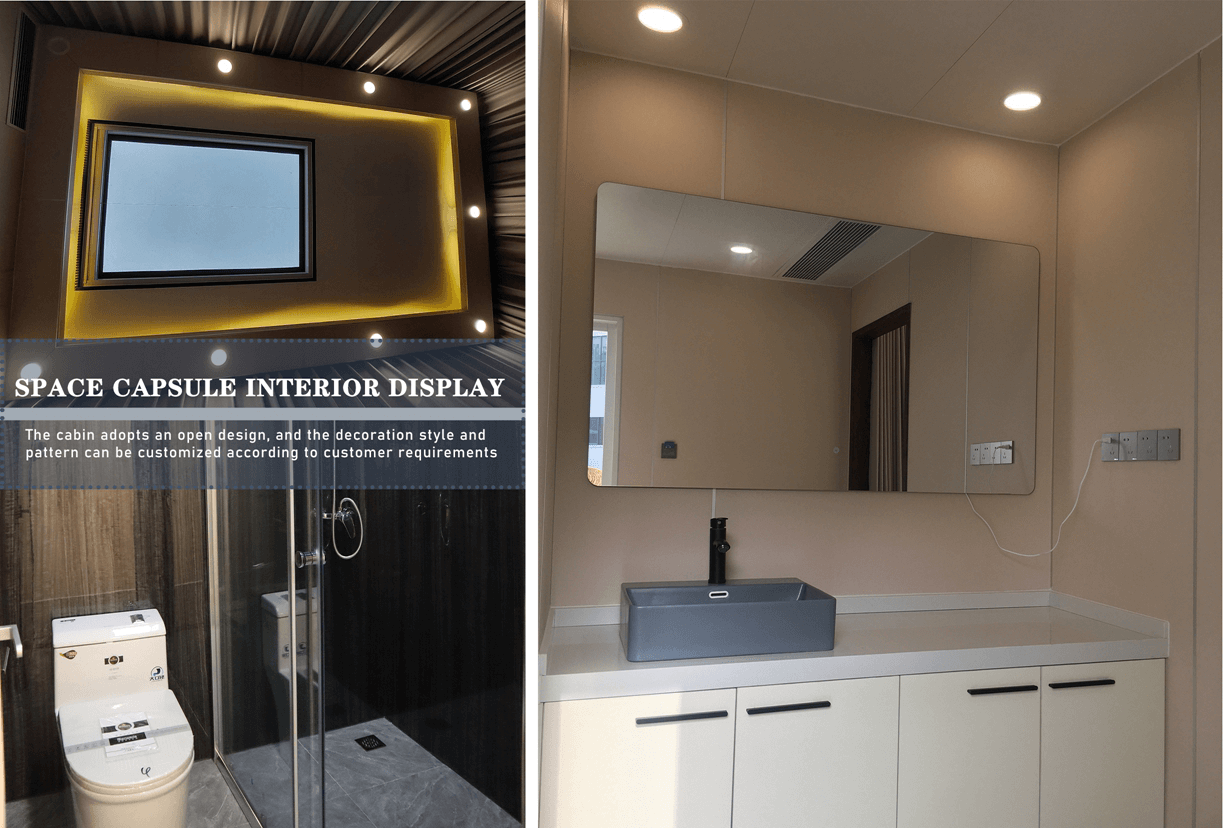Urban Space-Efficient Capsules aspects with rainwater harvesting in Laos
Product Details:
Place of origin: China
Certification: CE, FCC
Model Number: Model E7 Capsule | Model E5 Capsule | Apple Cabin | Model J-20 Capsule | Model O5 Capsule | QQ Cabin
Payment and shipping terms:
Minimum order quantity: 1 unit
Packaging Details: Film wrapping, foam and wooden box
Delivery time: 4-6 weeks after payment
Payment terms: T/T in advance
|
Product Name
|
Urban Space-Efficient Capsules aspects with rainwater harvesting in Laos |
|
Exterior Equipment
|
Galvanized steel frame; Fluorocarbon aluminum alloy shell; Insulated, waterproof and moisture-proof construction; Hollow tempered
glass windows; Hollow tempered laminated glass skylight; Stainless steel side-hinged entry door. |
|
Interior Equipment
|
Integrated modular ceiling &wall; Stone plastic composite floor; Privacy glass door for bathroom; Marble/tile floor for bathroom;
Washstand /washbasin /bathroom mirror; Toilet /faucet /shower /floor drain; Whole house lighting system; Whole house plumbing &electrical system; Blackout curtains; Air conditioner; Bar table; Entryway cabinet. |
|
Room Control Unit
|
Key card switch; Multiple scenario modes; Lights&curtains with intelligent integrated control; Intelligent voice control; Smart
lock. |
|
|
|
Send Inquiry



- 1
Rainwater management to prevent flooding and to enhance urban
Website:www.researchgate.net
Introduction:Rainwater management provides a tool to enrich living conditions in cities and to extend water availability for the various needs such as landscaping, gardening, cleaning and emergency response
- 2
Microcatchment Rainwater Harvesting CGIAR
Website:cgspace.cgiar.org
Introduction:more efficient and effective system, it is necessary to calculate the ratio between the two if data related to the area of concern in terms of rainfall, runoff, and crop water requirements are available (Moges, 2004). Major techniques The microcatchment rainwater-harvesting system is a method of collecting surface runoff from a small
- 3
Conventional and makeshift rainwater harvesting in rural
Website:www.tandfonline.com
Introduction:Statistical analysis shows that high income, a brick house with straight gutters and good water services facilitate conventional rainwater harvesting, while a household with only round huts is easily trapped into makeshift rainwater harvesting. For upscaling rainwater harvesting in rural areas, housing types need to be considered.
- 4
Smart Rain Water Harvesting for Smart Cities SpringerLink
Website:link.springer.com
Introduction:Various aspects of sustainability, the role of climate change, and smart water management for water sustainability in smart cities through the integration of technology have been described in Sect. 3. The detailed report of the case study on smart rainwater harvesting for smart cities has been presented in Sect. 4.
- 5
Water Special Issue Rainwater and Stormwater Harvesting
Website:www.mdpi.com
Introduction:Rainwater harvesting systems are often used as both an alternative water source and a stormwater management tool. Many studies have focused on the water-saving potential of these systems, but research into aspects that impact stormwater retention—such as demand patterns and climate change—is lacking.
- 6
Rainwater harvesting A review on conservation, creation
Website:www.sciencedirect.com
Introduction:Due to the increase in demand for water, RWH has been on a hike and termed as one of the best and economical means of conserving water. The present paper necessitates the call for Rainwater Harvesting and the factors associated with RWH like conservation, creation, and cost-effectiveness. 2. Objectives contemporaneous with present study.
- 7
SciELO Brasil Influence of rainfall and design criteria
Website:www.scielo.br
Introduction:ABSTRACT. Using rainwater harvesting (RWH) system is influenced by socioeconomic, environmental and technical factors. This work presents as analysis of the influence of the rainfall time series characteristics and design criteria on RWH performance of five Brazilian capitals with different climatic characteristic: Goiânia, João Pessoa, Manaus, Porto Alegre and São Paulo.
- 8
Sustainability Free Full-Text Integrated Water Resource
Website:www.mdpi.com
Introduction:Rainwater harvesting (RWH) is generally perceived as a promising cost-effective alternative water resource for potable and non-potable uses (water augmentation) and for reducing flood risks. The performance of RWH systems has been evaluated for various purposes over the past few decades. These systems certainly provide economic, environmental, and technological benefits of water uses. However
- 9
Assessment of Rainwater Harvesting Facilities Tank Size Based
Website:www.mdpi.com
Introduction:Factors affecting rainwater resource management for the present and future include population growth, urbanization, and climate change. Rainwater harvesting (RWH) allows multiple urban water-related issues to be mitigated. In this study, a spreadsheet-based daily water balance model was developed to analyze the existing laws and regulations regarding the storage tank size of RWH facilities
- 10
Rainwater harvesting systems to promote sustainable water
Website:pubs.aip.org
Introduction:In recent years, water reuse, conservation and recycling are being promoted to meet the growing water demand, and in this regard, rainwater harvesting (RWH) has received significant attention. This paper presents an overview of research on RWH systems through a bibliometric analysis and summarizing research undertaken by the Water Engineering
- 11
Rainwater Utilisation in Germany: Efficiency, Dimensioning
Website:www.researchgate.net
Introduction:Rainwater harvesting is an ancient practice currently used for flood and drought risk mitigation. It is a well-known solution with different levels of advanced technology associated with it.
- 12
Rainwater-Harvesting Technology SpringerLink
Website:link.springer.com
Introduction:Rainwater-harvesting technology, either for general-use purposes in a building or for groundwater recharging, involves a wide range of approaches and functional techniques for its planning, design, construction, and maintenance. The success and efficiency of rainwater harvesting in buildings fully depends on these four aspects of technology.
- 13
Urban rainwater harvesting systems: Research, implementation
Website:www.researchgate.net
Introduction:As runoff could increase on average by +27% in Burkina Faso and +13% in Ghana by 2050, adaptation measures should consider efficient drainage systems in urban places to mitigate rapid flow
- 14
Exploring environmental, economic and social aspects of
Website:www.sciencedirect.com
Introduction:Rainwater harvesting systems (RWHS) can significantly contribute to the sustainability of cities and rural areas. In addition to their more obvious benefits (such as the ability to supply water in a decentralized manner, increasing local water security), several other benefits such as better stormwater management can be obtained through the use of these systems.
- 15
Water Free Full-Text Rainwater Harvesting for Small
Website:www.mdpi.com
Introduction:The design of rainwater harvesting based gardens requires considering current climate but also climate change during the lifespan of the facility. The goal of this study is to present an approach for designing garden variants that can be safely supplied with harvested rainwater, taking into account climate change and adaptation measures. In addition, the study presents a methodology to
- 16
The Role of Rainwater Harvesting in Sustainable Water
Website:www.kingspan.com
Introduction:The Role of Rainwater Harvesting. Rainwater harvesting is defined as the collection and storage of rainwater before it is dispersed as surface run-off. Typically, a rainwater harvesting system collects the water running off a roof surface and passes it into a storage vessel. It’s a process that is by its nature inherently efficient; simply
- 17
Water savings and urban storm water management- PLOS
Website:journals.plos.org
Introduction:The main potential benefits of rainwater harvesting, namely water saving and storm water management, are easily evaluable at a building scale when well-known behavioral models are used. However, the evaluation is often more complex at an urban scale, due to a lack of building characteristics and demographic data. In the present paper, we propose a method, which is based on the representative
- 18
Feasibility analysis of a small-scale rainwater harvesting
Website:www.sciencedirect.com
Introduction:It is found that the small-scale rainwater harvesting system can satisfy the drinking water demand throughout the year with 90–97% reliability depending on the roof size. In addition, the capacity of monthly water production from different rainwater harvesting systems is presented that can be adopted to increase the reliability further.
- 19
Review Urban rainwater harvesting systems: Research,
Website:www.sciencedirect.com
Introduction:1. Introduction. Rainwater Harvesting (RWH) is probably the most ancient practice in use in the world to cope with water supply needs. In recent decades, as a result of new technological possibilities, many countries are supporting updated implementation of such practice to address the increase in water demand pressures associated with climatic, environmental and societal changes (Amos et al
- 20
Rainwater harvesting in South Africa: Challenges and
Website:www.sciencedirect.com
Introduction:Domestic rainwater harvesting aboveground tank (DRWH-AGT) collecting water from rooftop at the Glen research station (central South Africa). Fig. 4. Domestic rainwater harvesting underground tank (DRWH-UGT). Water collected from the ground surface is channelled into an underground tank (photo, dams for Africa).
Related Products
 Exclusive Space-Efficient Capsules resources with Australian solar tech
In the last decade, self-healing materials have become extremely appealing for the field of space applications, due to their technological evolution and the consequent possibility of designing space systems and structures able to repair autonomously after damage arising from impacts with micrometeoroids and orbital debris, from accidental contact with sharp objects, from structural fatigue or 4m2 of PV Ultra can produce as much energy as 5000m2 of conventional, silicon-based solar panels (though 2500m2 of heliostats are required to direct light onto it). The high-tech part of the system the receiver will be made in Australia and exported to the world.
Exclusive Space-Efficient Capsules resources with Australian solar tech
In the last decade, self-healing materials have become extremely appealing for the field of space applications, due to their technological evolution and the consequent possibility of designing space systems and structures able to repair autonomously after damage arising from impacts with micrometeoroids and orbital debris, from accidental contact with sharp objects, from structural fatigue or 4m2 of PV Ultra can produce as much energy as 5000m2 of conventional, silicon-based solar panels (though 2500m2 of heliostats are required to direct light onto it). The high-tech part of the system the receiver will be made in Australia and exported to the world.
 Space-Efficient Capsules aspects with Pacific Island designs from Lithuania
The Harwyn Pod is a tiny space for distraction-free work. Designed to be an office, art space or , each pod can pop-up on-site in just 5 hours and comes complete with built-in furniture. With a 3 March 2001, at 8:59am Moscow time, a group of Russian cosmonauts gazed up at the sky on the island of Fiji in the South Pacific, and waited. This was the moment the country
Space-Efficient Capsules aspects with Pacific Island designs from Lithuania
The Harwyn Pod is a tiny space for distraction-free work. Designed to be an office, art space or , each pod can pop-up on-site in just 5 hours and comes complete with built-in furniture. With a 3 March 2001, at 8:59am Moscow time, a group of Russian cosmonauts gazed up at the sky on the island of Fiji in the South Pacific, and waited. This was the moment the country
 Smart Space Capsules furnishings with rainwater harvesting in Myanmar
The feasibility of installing rainwater harvesting systems in buildings is usually defined based primarily on economic analysis. In this perspective, we reviewed the literature related to water consumption in buildings, rainwater use, and environmental assessment tools to evaluate the impact of rainwater harvesting on the environment. Identifying water end uses in buildings showed a high ntroduction:Statistical analysis shows that high income, a brick house with straight gutters and good water services facilitate conventional rainwater harvesting, while a household with only round huts is easily trapped into makeshift rainwater harvesting. For upscaling rainwater harvesting in rural areas, housing types need to be considered.
Smart Space Capsules furnishings with rainwater harvesting in Myanmar
The feasibility of installing rainwater harvesting systems in buildings is usually defined based primarily on economic analysis. In this perspective, we reviewed the literature related to water consumption in buildings, rainwater use, and environmental assessment tools to evaluate the impact of rainwater harvesting on the environment. Identifying water end uses in buildings showed a high ntroduction:Statistical analysis shows that high income, a brick house with straight gutters and good water services facilitate conventional rainwater harvesting, while a household with only round huts is easily trapped into makeshift rainwater harvesting. For upscaling rainwater harvesting in rural areas, housing types need to be considered.
 Urban Space-Efficient Capsules aspects with rainwater harvesting in Laos
Rainwater management provides a tool to enrich living conditions in cities and to extend water availability for the various needs such as landscaping, gardening, cleaning and emergency response tive system, it is necessary to calculate the ratio between the two if data related to the area of concern in terms of rainfall, runoff, and crop water requirements are available (Moges, 2004). Major techniques The microcatchment rainwater-harvesting system is a method of collecting surface runoff from a small
Urban Space-Efficient Capsules aspects with rainwater harvesting in Laos
Rainwater management provides a tool to enrich living conditions in cities and to extend water availability for the various needs such as landscaping, gardening, cleaning and emergency response tive system, it is necessary to calculate the ratio between the two if data related to the area of concern in terms of rainfall, runoff, and crop water requirements are available (Moges, 2004). Major techniques The microcatchment rainwater-harvesting system is a method of collecting surface runoff from a small
 Deluxe tiny houses prefab benefits with rainwater harvesting in Kuwait
15 rainwater harvesting benefits. Rainwater harvesting is a great way of taking advantage of a freely available natural resource. Even the simplest rainwater collection systems can have many benefits for households. Here are 15 need-to-know advantages of collecting rainwater: 1. Rainwater collection is free (wherever it is allowed) ion">Introduction:We will also discuss the benefits of living in a prefab tiny house, how to live comfortably in a small space, and the legal requirements for owning one. Additionally, we will provide an in-depth review and comparison of the top 5 eco-friendly prefab tiny house models and brands, including detailed features, pros, and cons, as well as price
Deluxe tiny houses prefab benefits with rainwater harvesting in Kuwait
15 rainwater harvesting benefits. Rainwater harvesting is a great way of taking advantage of a freely available natural resource. Even the simplest rainwater collection systems can have many benefits for households. Here are 15 need-to-know advantages of collecting rainwater: 1. Rainwater collection is free (wherever it is allowed) ion">Introduction:We will also discuss the benefits of living in a prefab tiny house, how to live comfortably in a small space, and the legal requirements for owning one. Additionally, we will provide an in-depth review and comparison of the top 5 eco-friendly prefab tiny house models and brands, including detailed features, pros, and cons, as well as price
 High-tech Space-Efficient Capsules details with guest accommodations in Vietnam
Set in the public areas of Noi Bai International Airport, VATC Sleep Pod provides sleeping pods on the second floor in Terminal 2. Complimentary WiFi can be accessed in all areas. Each capsule room is features a flat-screen TV with cable channels, a telephone and an alarm clock. Clean blankets, sheets and pillows are provided.
High-tech Space-Efficient Capsules details with guest accommodations in Vietnam
Set in the public areas of Noi Bai International Airport, VATC Sleep Pod provides sleeping pods on the second floor in Terminal 2. Complimentary WiFi can be accessed in all areas. Each capsule room is features a flat-screen TV with cable channels, a telephone and an alarm clock. Clean blankets, sheets and pillows are provided.
 Practical Urban Micro Capsules comparisons with rainwater harvesting in Finland
To address concern regarding water sustainability, the Australian Federal Government and many state governments have implemented regulatory mechanisms and incentives to support households to purchase and install rainwater harvesting systems. This has led to an increase in rainwater harvesting in regional and urban Australia. This review examines the implementation of the regulatory mechanisms dIn recent years, water reuse, conservation and recycling are being promoted to meet the growing water demand, and in this regard, rainwater harvesting (RWH) has received significant attention. This paper presents an overview of research on RWH systems through a bibliometric analysis and summarizing research undertaken by the Water Engineering
Practical Urban Micro Capsules comparisons with rainwater harvesting in Finland
To address concern regarding water sustainability, the Australian Federal Government and many state governments have implemented regulatory mechanisms and incentives to support households to purchase and install rainwater harvesting systems. This has led to an increase in rainwater harvesting in regional and urban Australia. This review examines the implementation of the regulatory mechanisms dIn recent years, water reuse, conservation and recycling are being promoted to meet the growing water demand, and in this regard, rainwater harvesting (RWH) has received significant attention. This paper presents an overview of research on RWH systems through a bibliometric analysis and summarizing research undertaken by the Water Engineering
 Artistic Luxury Space Capsules details with rainwater harvesting in Kuwait
Hold the new downspout elbow up and rest it on the existing downspout, about 2 inches above the top of the rain barrel inlet. Use a sharpie to make a mark on your downspout, about 2 inches below thwestern Kuwait, it presents a unique new scene of greenery , bringing a refreshing touch to the hot summer in the desert. This precious greenery” in the desert is the rainwater collection system” construction of the Kuwait Mutra Project Department of Energy China Gezhouba Group.
Artistic Luxury Space Capsules details with rainwater harvesting in Kuwait
Hold the new downspout elbow up and rest it on the existing downspout, about 2 inches above the top of the rain barrel inlet. Use a sharpie to make a mark on your downspout, about 2 inches below thwestern Kuwait, it presents a unique new scene of greenery , bringing a refreshing touch to the hot summer in the desert. This precious greenery” in the desert is the rainwater collection system” construction of the Kuwait Mutra Project Department of Energy China Gezhouba Group.













